Consuegra It is one of the main tourist destinations in the province of Toledo.
In fact it is probably the second most visited place after Toledo capital.
The greatest attraction is, without a doubt, the windmills that appear above the calderico hill, which dominates the population.
A detail that must be highlighted is that a considerable part of the visitors it receives Consuegra They are foreign travelers.
Everyone is attracted by the somewhat exotic image of windmills and their literary association with the Quijote.
All the information in detail
La Mancha, land of windmills
It is possible that we Spaniards, so accustomed to their presence, do not value the importance that these mills have in the image that foreigners form of our culture and our monumental and heritage attractions.
Several places in La Mancha where we can see windmills, But Consuegra It is the most accessible from Madrid and Toledo; In fact, it is common to add Consuegra to the excursions to Toledo.
If we travel along the A-4 highway, shortly after turning off in Madridejos we will already distinguish the classic image of the mills and the Consuegra castle dominating the horizon.
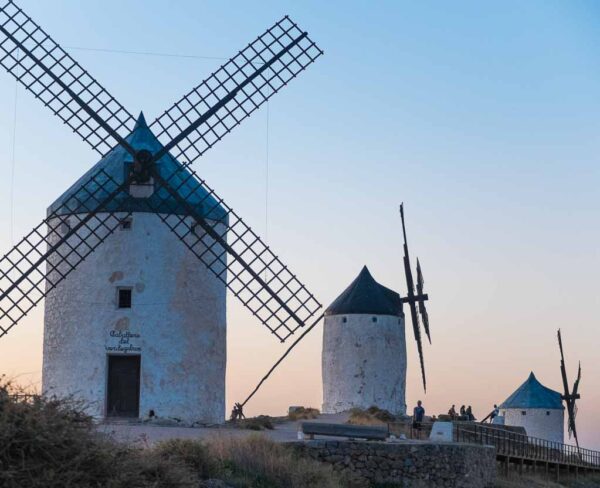
How to visit and where to see the Consuegra windmills
We may feel like heading straight to the mills as soon as we arrive.
It is not a bad idea since in one of them we will find the tourist office, where we can obtain information about the many other places that deserve to be known in this Toledo town.
From the top of this hill, between the mills, we will have a very good view of the surroundings, the nearby plains and the silhouette of the Toledo Mountains.
The hill, which is a witness to ancient geological eras, is very peculiar and has always been a place chosen for the possibilities of installing a fortress or any defensive structure there.
Where to sleep and guided tours in Consuegra
For your getaway, this information will be useful to you hotels and rural houses where can you stay in Consuegra and its surroundingsAs well as guided tours which you can sign up for
It is thought that in past times there was a population on the hill, which only descended to the plain when peaceful times arrived.
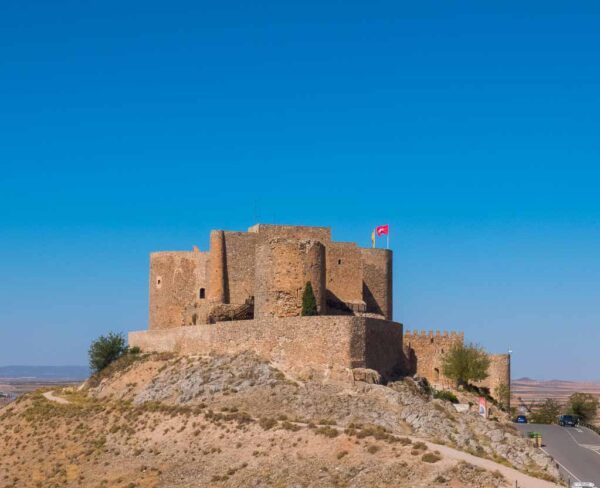
In Consuegra we will find traces of its Roman, Muslim and Christian past after the reconquest.
Although it is most likely that we will find most of the mills closed, some can be visited since some of them have been installed. shop with local products.
How many windmills are there in Consuegra?
El set of the 12 mills and the castle of Consuegra It is almost unique and there are very few places that can offer a minimally comparable image.
Consuegra It once had up to 13 mills, but one has disappeared. The high number is due to the high production of cereal in the area, which had to be ground.
The absence of rivers with sufficient force to move water mills meant that in La ManchaIn general, you will opt for wind ones.
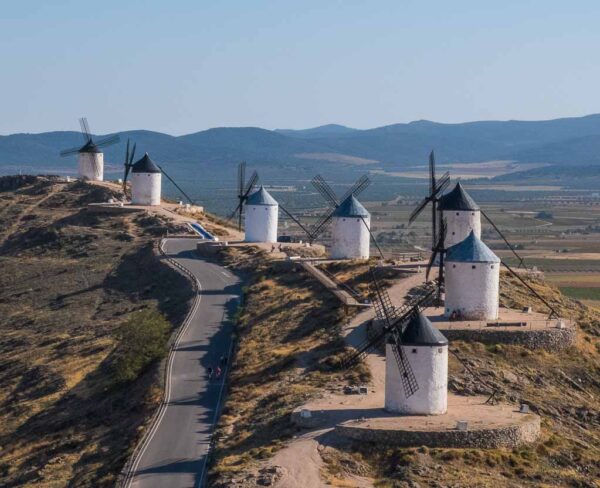
They are now, evidently, the image of Consuegra and the entire region.
How to visit a windmill in Consuegra
All the mills have an assigned name, and the one that is visited in full is known as "Bolero", where is the tourist office.
ORGANIZE your TRIP
- Don't forget your TRAVEL INSURANCE with a 5% discount
- Book the HOTEL for your trip
- RENT a CAR for your trip
- The best TOURS and EXCURSIONS in Spanish
- NO-LINE TICKETS for museums and monuments
- Best FREE TOURS around the world
- Book your TRANSFER from the airport
- eSIM card with INTERNET at the best price
It is interesting to see the upper part, where the gear and grinding stone are located.
The series of small windows makes it easy to know where the wind is coming from and thus rotate the upper structure to orient the blades, which should then be covered with fabrics.
La visit to the mill is paid, and the ticket also includes the visit to the castle and the Municipal Museum. In each of the three places the visitor will find a guide to take the tour.

How to visit Consuegra Castle
Castle It is another visit that should not be missed in Consuegra.
Although there was a Muslim fortress here, what we see now is the result of different transformations of the castle that was built in this place from the 11th century, after the Christian conquest.
Between the 11th and 12th centuries this region was part of the border and was entrusted to the knights of the Order of Saint John of Jerusalem.
After Battle of Las Navas de Tolosa in 1212, in what is now the Jaén province, the border moved much further south, this area was pacified and the castle stopped having so much importance.
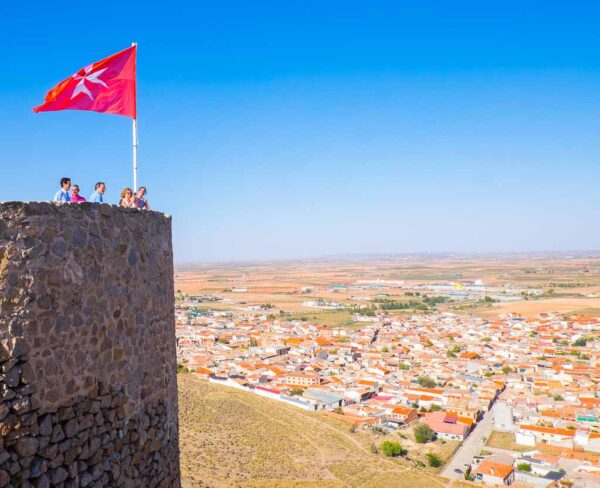
During the visit, which is done with a guide and in a group at certain times, different areas are visited. The most spectacular is the chapter house.
From the top of the main tower there is a great panoramic view of all the surroundings and it is perfectly understandable why this place was chosen to build such an important fortress.
Other interesting places to see in Consuegra
If we descend towards the urban area, we will have the opportunity to meet other interesting places.
The center of daily life is Plaza of Spain, which occupies the same place as the Roman forum of Consabura.
Here we find some of the unique buildings of Consuegra, representatives of both the traditional La Mancha architecture as the Castilian-Mudejar style.

Balcony of Los Corredores in Consuegra
An example of the first is the building of The runners, where the Archaeological Museum, which dates back to the 17th century, and which stands out for its balcony run on wood.
It should be noted that since wood was a scarce material in La Mancha, only rich populations could afford similar squares, which provided great prestige.
Examples of this can be found in wobbly o Almagro.
In the museum there is a tour of different topics related to history of Consuegra.
Just on the other side of the square we will see City Hall, a 17th century building Castilian Mudejar style.
Next to it is the Díaz-Cordovés Foundation, which is from the 20th century but imitates the traditional style of the Town Hall.
La Clock Tower, very tall and thin, completes the peculiar image of this square.
Don't forget your Travel Insurance
Are you organizing your trip or getaway? Don't leave without take out your travel insurance before, and here we explain why. If you hire it with us, you have a 5% discount

Cristo de la Vera Cruz, marble and brick church in Consuegra
Throughout the urban area of Consuegra there are good examples of religious architecture.
The most unique case is the Church of Christ of the True Cross.
We see that its exterior has a brick part, as is very common in other buildings in La Mancha, but it also has a marble part, at the entrance.
It is said that it was going to be completely covered in marble, but someone decided to use that material for other projects, stealing it from here.

The combination of marble and brick makes this church a peculiar case.
El Alfar, traditional La Mancha architecture
A place that should not be missed in Consuegra is The Alfar, a good example of the typical traditional La Mancha architecture.
In its patio we will see two kilns, one Roman and the other Arab, heritage of the pottery tradition of the region. There are also several Roman archaeological remains.
Currently in The Alfar works a very good restaurant, making it a good option to eat during our visit.
Collection of paintings and sculptures by Vicente Manzano
There are still two places to visit, but outside the urban area.
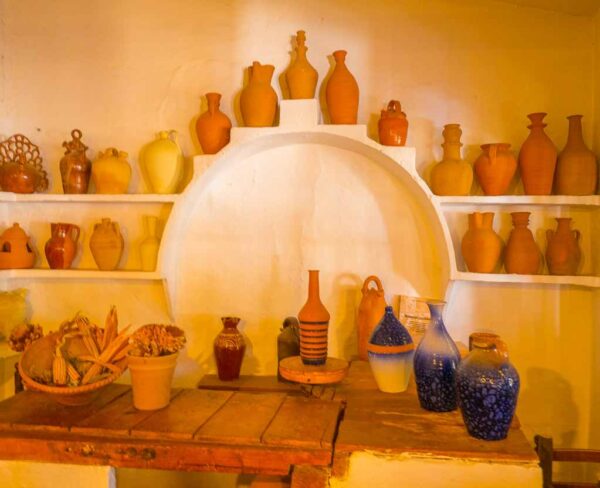
The first is the call Lizard Well, which is just on the outskirts.
It is a collection of paintings, but above all sculptures, Local artist Vicente Manzano.
Most of the sculptures are busts of writers, artists and scientists, and all of this is displayed on the grounds and buildings of an old dairy farm.
Roman dam in Consuegra
About four kilometers away we will find the second longest surviving Roman dam in Western Europe.
It is a construction of about 650 meters in length that served to store water and control the floods of the river. Amarguillo River.
The retaining wall is in fairly good condition. In addition, some buttresses and the spillway stand out, a curious vaulted structure that allowed the desired amount of water to be emptied.
Book your hotel, 15% discount, free cancellation
When planning your trip, we advise you to, well in advance, Book your hotel now on booking.com where you can find discounts from 15% and you will have a possible cancellation for free


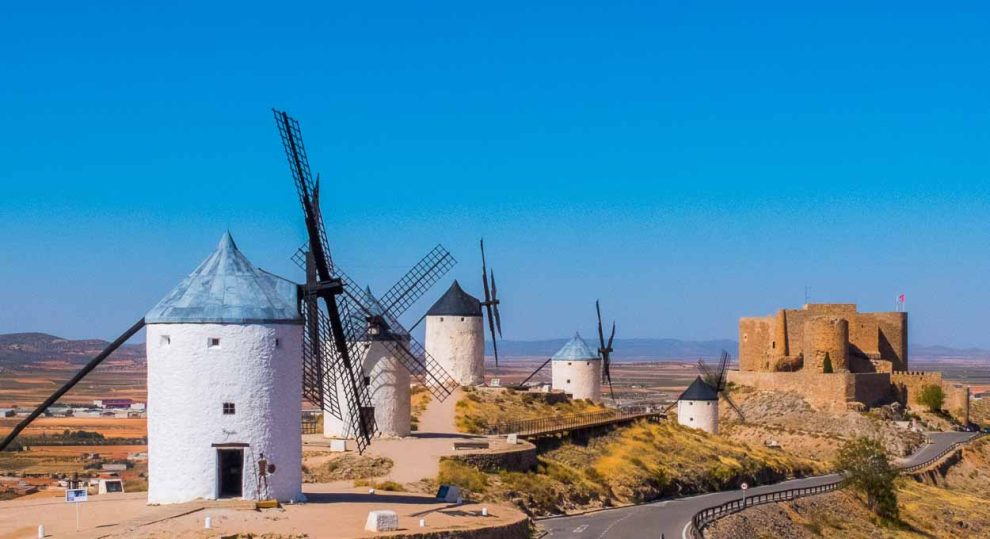


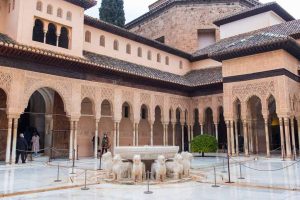











Comment